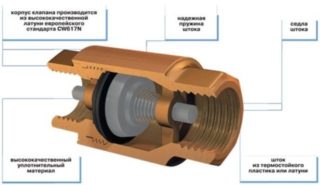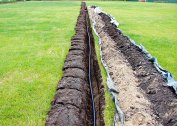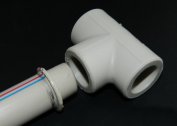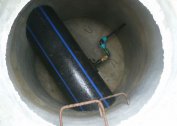For the water supply system in a private house to work correctly, a check valve for the pump is required. If it is not installed or broken, the pumping station does not function correctly. The water flow arrives at the point of consumption with a delay and with a weak draft of the pressure equipment completely disappears. The presence of a non-return valve facilitates the instantaneous production of water as soon as the tap opens.
Definition and purpose of the check valve
A direct acting safety device blocks the return flow of fluid in the water supply system. It works automatically.
Return devices are necessary elements of an autonomous water supply network. Their main function is to protect pipelines and pressure devices in the event of an accident.
Depending on the type of element it is installed in a vertical or horizontal position. Installation is carried out in strict accordance with the direction of movement of the water stream.
Valve classification
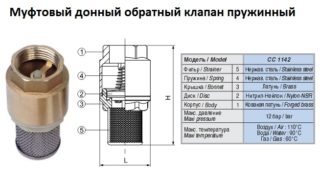 Equipment differs in design, material, size. Each has its own characteristics during installation.
Equipment differs in design, material, size. Each has its own characteristics during installation.
According to the design features of the device are as follows:
- With lifting element. The valve is equipped with a shutter that rises or falls with blocking the water flow. When liquid enters, the locking part goes up and passes it. When the pressure decreases, the shutter goes down and blocks the return stroke of the water stream. The movement of the mechanism occurs using a spring.
- With ball type shutter. Under pressure, the ball moves and water flows through the system. After the pressure drops, the overlay element returns to its place.
- With disk-shaped constipation. The disk blocks the return flow due to the spring device.
- With two shutter leaves. They fold under pressure, and when pressure drops, they come back.
In everyday life, equipment with a lifting type mechanism is most often used. It is easy to repair, replacing the spring.
Devices are made of various materials. Brass elements are not subject to corrosion, are easily maintained, are installed on all types of pipes. Locking devices in a cast iron case are not used often. This material rusts, sediments settle on it quite quickly. Such valves are only suitable for wide lines.
Stainless steel cases are the most reliable, but also the most expensive. Steel valves do not rust and are not affected by aggressive media, deposits do not accumulate inside them.
Most of the elements are mounted using a coupling connection. To do this, you will need two threaded adapters, selected according to the cross-section of the pipeline system. Flange joints bolted together may also be used. This type of mount is used for small devices when there is not enough space on the pipes for another fixation. They are usually equipped with valves made of cast iron of large cross-section.
The price of the product depends on the combination of these parameters, as well as the brand. The average cost is 700 rubles.
Installation steps
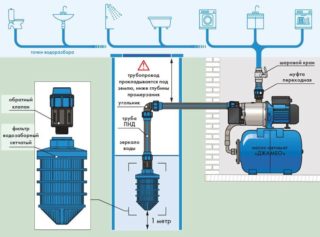 When selecting a non-return valve, it is necessary to take into account the nominal pressure indicators, the throughput and the bore diameter. All these data are indicated in technical documents. You can do the installation yourself, guided by the attached manual.
When selecting a non-return valve, it is necessary to take into account the nominal pressure indicators, the throughput and the bore diameter. All these data are indicated in technical documents. You can do the installation yourself, guided by the attached manual.
Depending on the location, the shutoff valves are divided into bottom and pipeline.The first type of valves prevents the return of water flow raised from a well or an Abyssinian well when the station is turned off. The latter protect against a decrease in pressure in the water supply network.
The valve element is connected to the autonomous system immediately after the pump or in front of it. The first option is chosen if the pump unit is able to start with the tap closed. The pressure element can be equipped with an integrated transition fitting for the suction pipe. If it is missing, you need to buy this part and put it on the pump.
Self-installation of a non-return valve is carried out in the following order:
- They select the model and check the performance. To do this, purge the mouth from two sides. It opens with one shutter, with the other holding air.
- Identify the correct mounting direction in the direction of the arrow on the housing.
- Screw the valve element onto the thread, having wound the seal in advance.
- Tighten the locking equipment with a gas key. The main thing is not to overdo it - the body is able to burst.
If it is possible to drain from the system or the pump can operate in reverse mode, it is impossible to install the valve part after the hydraulic accumulator - it will block the outflow of liquid.
The bottom valve is placed together with a strainer that purifies water from sand and protects the inside of the device from wear. The least contaminated devices are equipped with a spring element and a lifting lock. In order to correctly install a non-return valve with a strainer at the pump station, it is better to immediately purchase the option with a mesh. There are products with a removable filter element for easy replacement.
The easiest way is to install the valve using the wafer joint. But in private homes, devices with a threaded coupling are mainly used because of their cheapness.
It is necessary to check the operation of the non-return valve for the pump station and after installation. To do this, turn the lever in the right direction. The result is a water supply.
Possible installation errors
Common errors when arranging a non-return valve:
- flow direction not taken into account;
- the connections are poorly sealed, which can lead to leaks when the shutter is closed;
- the section of the device is too large, so it knocks during operation;
- the valve is too close to the pump, which causes rattling;
- a lot of plumbing flax was used when wrapping the thread - the coupling may crack.
Sometimes they forget to remove the through hole plug or shutter latch.
Expert Advice
For a water supply network, it is better to choose valves made of brass or stainless steel, since they are not afraid of rust and have a long service life.
It is also necessary to consider:
- The location of the device in sewage pipelines without a ladder is selected on a site above the highest water discharge point - not lower than 350 mm from the floor.
- In homes with independent heating, the valve should be placed on the return line before connecting to the heating system.
- In high-rise buildings where a separate water supply network is mounted, valves are mounted after the water meter.
Installation of a non-flange valve is carried out after the flanges on the pipe are mounted by welding. It is extremely important that the pipes are aligned at the installation point of the device, since skewing will damage the joint.
Installation of check valves allows you to get rid of many problems that await the owners of an independent water supply system. The locking elements will not only provide network functionality, but also save money on repairs.
